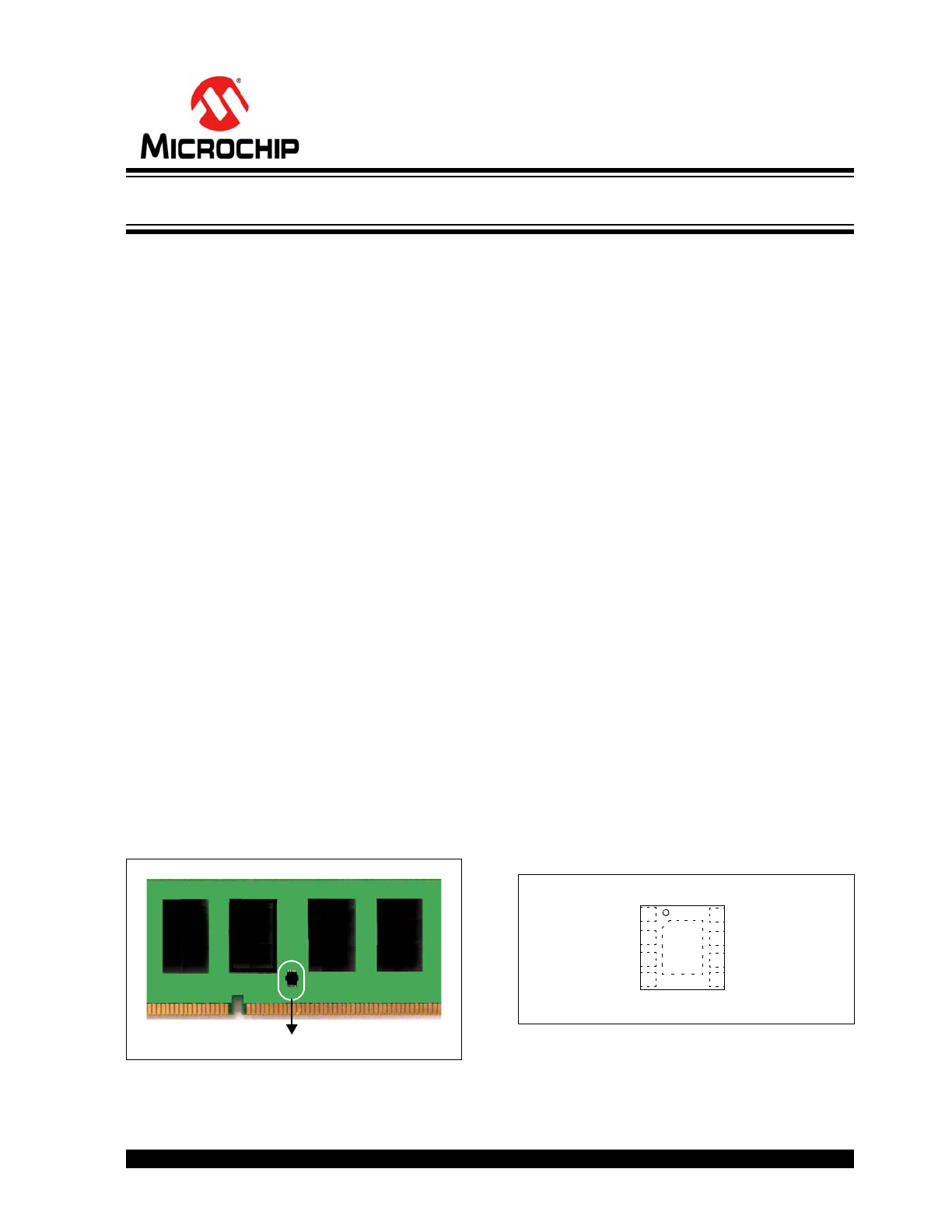
2012-2013 Microchip Technology Inc.
DS22327C-page 1
MCP98244
Features
• Meets JEDEC Specification
- MCP98244 --> JC42.4-TSE2004B1
Temperature Sensor with 4 Kbit Serial
EEPROM for Serial Presence Detect (SPD)
• 1MHz, 2-wire I
2
C™ Interface
• Specified V
DD
Range: 1.7V to 3.6V
• Operating Current: 100 µA (typ., EEPROM Idle)
• Available Package: TDFN-8
Temperature Sensor Features
• Temperature-to-Digital Converter (°C)
• Sensor Accuracy (Grade B):
- ±0.2°C/±1°C (typ./max.)
+75°C to +95°C
- ±0.5°C/±2°C (typ./max.)
+40°C to +125°C
- ±1°C/±3°C (typ./max.)
-40°C to +125°C
Serial EEPROM Features
• Operating Current:
- Write
250 µA (typical) for 3 ms (typical)
- Read
100 µA (typical)
• Reversible Software Write Protect
• Software Write Protection for each 1 Kbit Block
• Organized as two banks of 256 x 8-bit (2 Kbit x 2)
Typical Applications
• DIMM Modules for Servers, PCs, and Laptops
• Temperature Sensing for Solid State Drive (SSD)
• General Purpose Temperature Datalog
Description
Microchip Technology Inc.’s MCP98244 digital
temperature sensor converts temperature from -40°C
and +125°C to a digital word. This sensor meets
JEDEC Specification JC42.4-TSE3000B1 Memory
Module Thermal Sensor Component. It provides an
accuracy of ±0.2°C/±1°C (typical/maximum) from
+75°C to +95°C with an operating voltage of 1.7V to
3.6V. In addition, MCP98244 has an integrated
EEPROM with two banks of 256 by 8 bit EEPROM (4k
Bit) which can be used to store memory module details
and vendor information.
The MCP98244 digital temperature sensor comes with
user-programmable registers that provide flexibility for
DIMM temperature-sensing applications. The registers
allow user-selectable settings such as Shutdown or
Low-Power modes and the specification of
temperature Event boundaries. When the temperature
changes beyond the specified Event boundary limits,
the MCP98244 outputs an Alert signal at the Event pin.
The user has the option of setting the temperature
Event output signal polarity as either an active-low or
active-high comparator output for thermostat operation,
or as a temperature Event interrupt output for
microprocessor-based systems.
The MCP98244 EEPROM is designed specifically for
DRAM DIMMs (Dual In-line Memory Modules) Serial
Presence Detect (SPD). It has four 128 Byte pages,
which can be Software Write Protected individually.
This allows DRAM vendor and product information to
be stored and write-protected.
This sensor has an industry standard I
2
C Fast Mode
Plus compatible 1 MHz serial interface.
Package Types
DIMM MODULE
MCP98244
8-Pin 2x3 TDFN*
* Includes Exposed Thermal Pad (EP); see
Table 3-1
.
SCL
Event
SDA
A1
A2
1
2
3
4
8
7
6
5
GND
A0
V
DD
EP
9
DDR4 DIMM Temperature Sensor with EEPROM for SPD

MCP98244
DS22327C-page 2
2012-2013 Microchip Technology Inc.
NOTES:

2012-2013 Microchip Technology Inc.
DS22327C-page 3
MCP98244
1.0
ELECTRICAL
CHARACTERISTICS
Absolute Maximum Ratings †
V
DD
.................................................................................. 4.0V
Voltage at all Input/Output pins ............... GND – 0.3V to 4.0V
Pin A0 .......................................................GND – 0.3V to 11V
Storage temperature .....................................-65°C to +150°C
Ambient temp. with power applied ................-40°C to +125°C
Junction Temperature (T
J
) .......................................... +150°C
ESD protection on all pins (HBM:MM) ................. (4 kV:200V)
Latch-Up Current at each pin (25°C) ....................... ±200 mA
†Notice:
Stresses above those listed under “Maximum
ratings” may cause permanent damage to the device. This is
a stress rating only and functional operation of the device at
those or any other conditions above those indicated in the
operational listings of this specification is not implied.
Exposure to maximum rating conditions for extended periods
may affect device reliability.
TEMPERATURE SENSOR DC CHARACTERISTICS
Electrical Specifications:
Unless otherwise indicated, V
DD
= 1.7V to 3.6V, GND = Ground,
and T
A
= -40°C to +125°C.
Parameters
Sym
Min
Typ
Max
Unit
Conditions
Temperature Sensor Accuracy
+75°C < T
A
+95°C
T
ACY
-1.0
±0.2
+1.0
°C
JC42.4 - TSE2004B1
Grade B Accuracy Specification
V
DD
= 1.7V to 3.6V
+40°C < T
A
+125°C
-2.0
±0.5
+2.0
°C
-40°C < T
A
+125°C
-3.0
±1
+3.0
°C
Temperature Conversion Time
0.5°C/bit
t
CONV
—
30
—
ms
0.25°C/bit
—
65
125
ms 15 s/sec (typical) (See Section
5.2.4
)
0.125°C/bit
—
130
—
ms
0.0625°C/bit
—
260
—
ms
Power Supply
Specified Voltage Range
V
DD
1.7
—
3.6
V
Operating Current
I
DD_TS
—
100
500
µA
EEPROM Inactive
Shutdown Current
I
SHDN
—
0.2
1
µA
EEPROM Inactive, I
2
C Bus Inactive,
T
A
= 85°C
Power On Reset (POR)
V
POR
—
1.4
1.6
V
Threshold for rising and falling V
DD
Settling Time after POR
t
POR
—
—
1
ms For warm and cold power cycles
Line Regulation
°C
—
0.2
—
°C
V
DD
= 1.7V to 3.6V
Event Output (Open-Drain output, external pull-up resistor required), see Section
5.2.3
High-Level Current (leakage)
I
OH
—
—
1
µA
V
OH
= V
DD
Low-Level Voltage
V
OL
—
—
0.4
V
I
OL
= 3 mA (Active-Low, Pull-up
Resistor)
Thermal Response, from +25°C (Air) to +125°C (oil bath)
TDFN-8
t
RES
—
0.7
—
s
Time to 63% (89°C)

MCP98244
DS22327C-page 4
2012-2013 Microchip Technology Inc.
TEMPERATURE CHARACTERISTICS
MCP98244 EEPROM DC CHARACTERISTICS
Electrical Specifications:
Unless otherwise indicated, V
DD
= 1.7V to 3.6V, GND = Ground,
and T
A
= -40°C to +125°C.
Parameters
Sym
Min
Typ
Max
Unit
Conditions
Current, EEPROM write (for t
WC
)
I
DD_EE
—
250
2000
µA
Sensor in Shutdown Mode
Current, EEPROM read
I
DD_EE
—
100
500
µA
Write Cycle time (byte/page)
t
WC
—
3
5
ms
Endurance T
A
= +25°C
—
—
10k
—
cycles Write Cycles, V
DD
= 3.3V (
Note 1
,
Note 2
)
EEPROM Write Temperature
EE
WRITE
0
—
85
°C
EEPROM Read Temperature
EE
READ
-40
—
125
°C
For minimum read temperature, see
Note 1
Write Protect Voltage
SWP and CWP Voltage
V
HV
7
—
10
V
Applied at A0 pin
Note 1:
Characterized but not production tested.
2:
For endurance estimates in a specific application, please consult the Total Endurance™ Model, which can
be obtained from Microchip’s web site at
www.microchip.com/TotalEndurance
.
INPUT/OUTPUT PIN DC CHARACTERISTICS
Electrical Specifications:
Unless otherwise indicated, V
DD
= 1.7V to 3.6V, GND = Ground and
T
A
= -40°C to +125°C.
Parameters
Sym
Min
Typ
Max
Units
Conditions
Serial Input/Output (SCL, SDA, A0, A1, A2)
Input
High-Level Voltage
V
IH
0.7V
DD
—
—
V
Low-Level Voltage
V
IL
—
—
0.3V
DD
V
Input Current
I
IN
—
—
±5
µA
SDA and SCL only
Input Impedance (A0, A1, A2)
Z
IN
—
1
—
M
V
IN
> V
IH
Input Impedance (A0, A1, A2)
Z
IN
—
200
—
k
V
IN
< V
IL
Output (SDA only)
Low-Level Voltage
V
OL
—
—
0.4
V
I
OL
= 3 mA
High-Level Current (leakage)
I
OH
—
—
1
µA
V
OH
= V
DD
Low-Level Current
I
OL
20
—
—
mA
V
OL
= 0.4V; V
DD
≥ 2.2V
6
—
—
mA
V
OL
= 0.6V
Capacitance
C
IN
—
5
—
pF
SDA and SCL Inputs
Hysteresis
V
HYST
—
0.05V
DD
—
V
Spike Suppression
T
SP
—
—
50
ns
Electrical Specifications:
Unless otherwise indicated, V
DD
= 1.7V to 3.6V, GND = Ground,
and T
A
= -40°C to +125°C.
Parameters
Sym
Min
Typ
Max
Units
Conditions
Temperature Ranges
Specified Temperature Range
T
A
-40
—
+125
°C
Note 1
Operating Temperature Range
T
A
-40
—
+125
°C
Storage Temperature Range
T
A
-65
—
+150
°C
Thermal Package Resistances
Thermal Resistance, 8L-TDFN
JA
—
52.5
—
°C/W
Note 1:
Operation in this range must not cause T
J
to exceed Maximum Junction Temperature (+150°C).
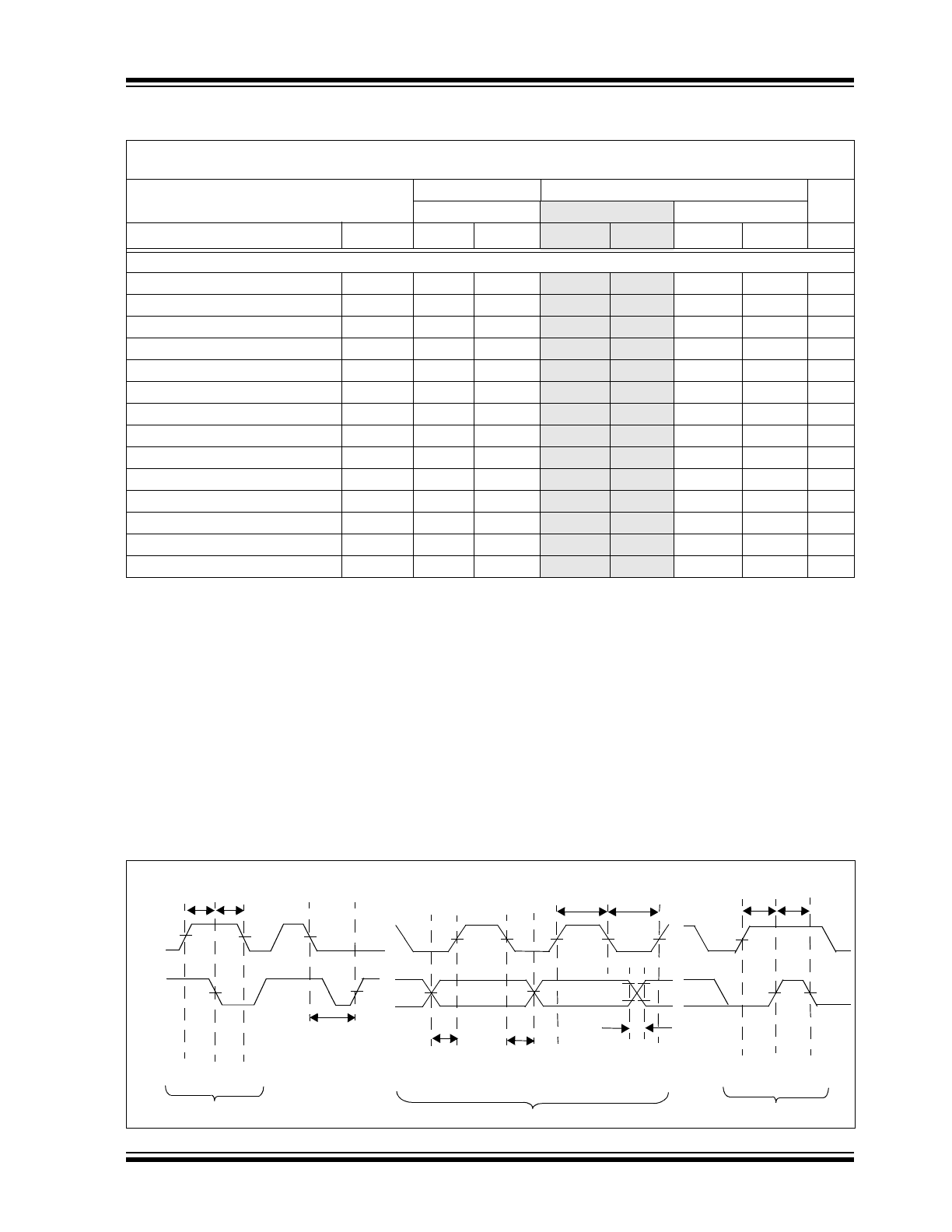
2012-2013 Microchip Technology Inc.
DS22327C-page 5
MCP98244
TIMING DIAGRAM
SERIAL INTERFACE TIMING SPECIFICATIONS
Electrical Specifications:
Unless otherwise indicated, GND = Ground, T
A
= -40°C to +125°C, and C
L
= 80 pF
(
Note 1
)
.
V
DD
= 1.7V to 3.6V
V
DD
= 2.2V to 3.6V
100 kHz
400 kHz
1000 KHz
Parameters
Sym
Min
Max
Min
Max
Min
Max
Units
2-Wire I
2
C Interface
Serial port frequency (
Note 2
,
4
)
f
SCL
10
100
10
400
10
1000
kHz
Low Clock (
Note 2
)
t
LOW
4700
—
1300
—
500
—
ns
High Clock
t
HIGH
4000
—
600
—
260
—
ns
Rise time
(
Note 5
)
t
R
—
1000
20
300
—
120
ns
Fall time (
Note 5
)
t
F
20
300
20
300
—
120
ns
Data in Setup time (
Note 3
)
t
SU:DAT
250
—
100
—
50
—
ns
Data in Hold time (
Note 6
)
t
HD:DI
0
—
0
—
0
—
ns
Data out Hold time (
Note 4
)
t
HD:DO
200
900
200
900
0
350
ns
Start Condition Setup time
t
SU:STA
4700
—
600
—
260
—
ns
Start Condition Hold time
t
HD:STA
4000
—
600
—
260
—
ns
Stop Condition Setup time
t
SU:STO
4000
—
600
—
260
—
ns
Bus Idle/Free
t
B-FREE
4700
—
1300
—
500
—
ns
Time out
t
OUT
25
35
25
35
25
35
ms
Bus Capacitive load
C
b
—
—
—
400
—
100
pf
Note 1:
All values referred to V
IL MAX
and V
IH MIN
levels.
2:
If t
LOW
> t
OUT
, the temperature sensor I
2
C interface will time out. A Repeat Start command is required for
communication.
3:
This device can be used in a Standard-mode I
2
C-bus system, but the requirement t
SU:DAT
250 ns must
be met. This device does not stretch SCL Low period. It outputs the next data bit to the SDA line within
t
R MAX
+ t
SU:DAT MIN
= 1000 ns + 250 ns = 1250 ns (according to the Standard-mode I
2
C-bus specification)
before the SCL line is released.
4:
As a transmitter, the device provides internal minimum delay time t
HD:DAT MIN
to bridge the undefined
region (min. 200 ns) of the falling edge of SCL t
F MAX
to avoid unintended generation of Start or Stop
conditions.
5:
Characterized but not production tested.
6:
As a receiver, SDA should not be sampled at the falling edge of SCL. SDA can transition t
HD:DI
0 ns after
SCL toggles Low.
t
SU
:S
TO
t
SU
:D
I
t
SU
:D
I
t
SU
:S
TO
t
B:
FR
EE
SC
L
SD
A
t
HD
:D
I
/ t
HD:
DO
t
HIG
H
t
LOW
t
OU
T
t
R
, t
F
Start Condition
Data Transmission
Stop Condition
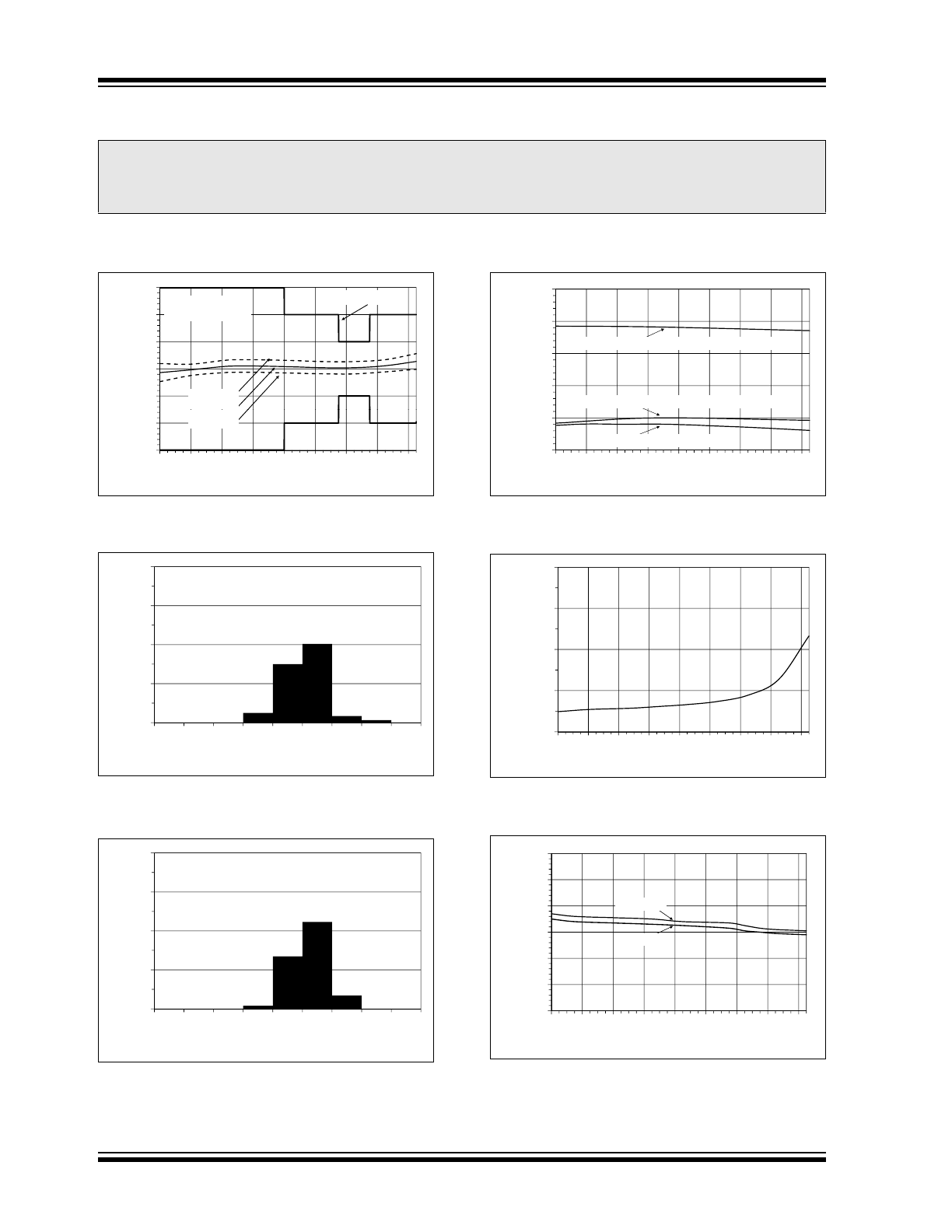
MCP98244
DS22327C-page 6
2012-2013 Microchip Technology Inc.
2.0
TYPICAL PERFORMANCE CURVES
Note:
Unless otherwise indicated, V
DD
= 1.7V to 3.6V, GND = Ground, SDA/SCL pulled-up to V
DD
, and
T
A
= -40°C to +125°C.
FIGURE 2-1:
Temperature Accuracy.
FIGURE 2-2:
Temperature Accuracy
Histogram, T
A
= + 85 °C.
FIGURE 2-3:
Temperature Accuracy
Histogram, T
A
= + 105 °C.
FIGURE 2-4:
Supply Current Vs.
Temperature.
FIGURE 2-5:
Shutdown Current Vs.
Temperature.
FIGURE 2-6:
Power On Reset Threshold
Voltage Vs. Temperature.
Note:
The graphs and tables provided following this note are a statistical summary based on a limited number of
samples and are provided for informational purposes only. The performance characteristics listed herein
are not tested or guaranteed. In some graphs or tables, the data presented may be outside the specified
operating range (e.g., outside specified power supply range) and therefore outside the warranted range.
-1.0
0.0
1.0
2.0
3.0
e
rature Accuracy
(°C)
V
DD
= 1.7 V to 3.6 V
16 units
Spec. Limits
+Std. Dev.
Average
-3.0
-2.0
-40
-20
0
20
40
60
80
100
120
Te
m
p
e
T
A
(°C)
g
-Std. Dev.
25%
50%
75%
100%
Occurrences
T
A
= +85 °C
V
DD
= 1.7 V - 3.6 V
16 units
0%
-1.00
-0.75
-0.50
-0.25
0.00
0.25
0.50
0.75
1.00
Temperature Accuracy (°C)
25%
50%
75%
100%
Occurrences
T
A
= +25 °C
V
DD
= 1.7 V - 3.6 V
16 units
0%
-1.00
-0.75
-0.50
-0.25
0.00
0.25
0.50
0.75
1.00
Temperature Accuracy (°C)
150
200
250
300
I
DD
(µA)
EEPROM Write (Sensor in Shutdown Mode)
EEPROM Read (Sensor in Shutdown Mode)
50
100
-40
-20
0
20
40
60
80
100
120
T
A
(°C)
Sensor (EEPROM Inactive)
0 25
0.50
0.75
1.00
I
SHDN
(µA)
0.00
0.25
-40
-20
0
20
40
60
80
100
120
T
A
(°C )
1
1.2
1.4
1.6
1.8
V
PO
R
(V)
Falling V
DD
Rising V
DD
0.6
0.8
-40
-20
0
20
40
60
80
100
120
T
A
(°C)
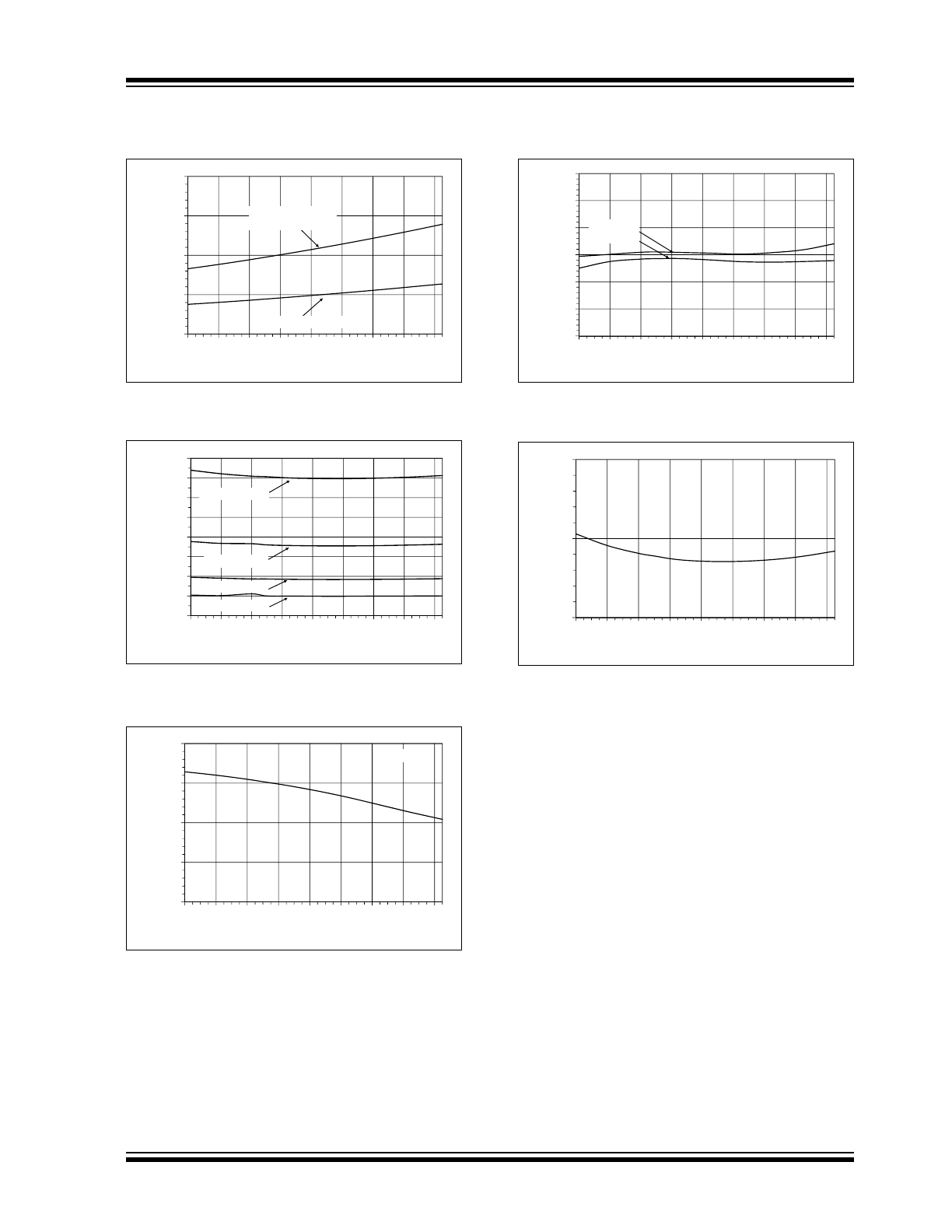
2012-2013 Microchip Technology Inc.
DS22327C-page 7
MCP98244
Note:
Unless otherwise indicated, V
DD
= 1.7V to 3.6V, GND = Ground, SDA/SCL pulled-up to V
DD
, and
T
A
= -40°C to +125°C.
FIGURE 2-7:
Event Output and SDA V
OL
Vs. Temperature.
FIGURE 2-8:
Temperature Conversion
Rate Vs. Temperature.
FIGURE 2-9:
SDA I
OL
Vs. Temperature.
FIGURE 2-10:
Line Regulation: Change in
Temperature Accuracy Vs. Change in V
DD
.
FIGURE 2-11:
I
2
C Protocol Time-out Vs.
Temperature.
0 1
0.2
0.3
0.4
e
nt & SDA
V
OL
(V)
SDA, I
OL
= 20 mA
V
DD
= 2.2 V to 3.6 V
0
0.1
-40
-20
0
20
40
60
80
100
120
Ev
e
T
A
(°C)
Event, I
OL
= 3 mA
50
75
100
125
150
175
200
t
CONV
(ms)
0.0625 °C/LSb
0.125 °C/LSb
0
25
50
-40
-20
0
20
40
60
80
100
120
T
A
(°C)
0.25 °C/LSb
0.5 °C/LSb
20
30
40
50
SDA
I
OL
(mA)
V
OL
= 0.6V
10
20
-40
-20
0
20
40
60
80
100
120
T
A
(°C)
-1.0
0.0
1.0
2.0
3.0
lized T
e
mp. Error (°C)
V
DD
= 1.7 V
V
DD
= 3.6 V
-3.0
-2.0
-40
-20
0
20
40
60
80
100
120
Norma
l
T
A
(°C)
30
35
C
Bus t
OUT
(ms)
25
-40
-20
0
20
40
60
80
100
120
I
2
C
T
A
(°C)

MCP98244
DS22327C-page 8
2012-2013 Microchip Technology Inc.
3.0
PIN DESCRIPTION
The descriptions of the pins are listed in
Table 3-1
.
TABLE 3-1:
PIN FUNCTION TABLES
3.1
Address Pins (A0, A1, A2)
These pins are device address input pins.
The address pins correspond to the Least Significant
bits (LSb) of address bits. The Most Significant bits
(MSb) are (A6, A5, A4, A3). This is shown in
Table 3-2
.
The A0 Address pin is a multi-function pin. This input
pin is also used for high voltage input V
HV
to enable the
EEPROM Software Write Protect feature, for more
information see
Section 5.3.3 “Bank or page selec-
tion for EEPROM Read/write operation”
.
All address pin have an internal pull-down resistors.
3.2
Ground Pin (GND)
The GND pin is the system ground pin.
3.3
Serial Data Line (SDA)
SDA is a bidirectional input/output pin, used to serially
transmit data to/from the host controller. This pin
requires a pull-up resistor. (See
Section 4.0 “Serial
Communication”
).
3.4
Serial Clock Line (SCL)
The SCL is a clock input pin. All communication timing
is relative to the signal on this pin. The clock is gener-
ated by the host or master controller on the bus. (See
Section 4.0 “Serial Communication”
).
3.5
Temperature Alert, Open-Drain
Output (Event)
The MCP98244 temperature Event output pin is an
open-drain output. The device outputs a signal when
the ambient temperature goes beyond the user-pro-
grammed temperature limit. (see
Section 5.2.3 “Event
Output Configuration”
).
3.6
Power Pin (V
DD
)
V
DD
is the power pin. The operating voltage range, as
specified in the DC electrical specification table, is
applied on this pin.
3.7
Exposed Thermal Pad (EP)
There is an internal electrical connection between the
Exposed Thermal Pad (EP) and the GND pin; they can
be connected to the same potential on the Printed
Circuit Board (PCB). This provides better thermal
conduction from the PCB to the die.
MCP98244
Symbol
Description
TDFN
1
A0
Slave Address and EEPROM Software Write Protect High Voltage Input (V
HV
)
2
A1
Slave Address
3
A2
Slave Address
4
GND
Ground
5
SDA
Serial Data Line
6
SCL
Serial Clock Line
7
Event
Temperature Alert Output
8
V
DD
Power Pin
9
EP
Exposed Thermal Pad (EP); can be connected to GND.
TABLE 3-2:
MCP98244 ADDRESS BYTE
Device
Address Code
Slave
Address
A6
A5
A4
A3
A2
A1
A0
Sensor
0
0
1
1
X
1
X
1
X
1
EEPROM
1
0
1
0
EEPROM
Write Protect
0
1
1
0
—
2
—
2
—
2
Note 1:
User-selectable address is shown by X,
where X is 1 or 0 for V
DD
and GND,
respectively.
2:
The address pins are ignored for all Write
Protect commands.
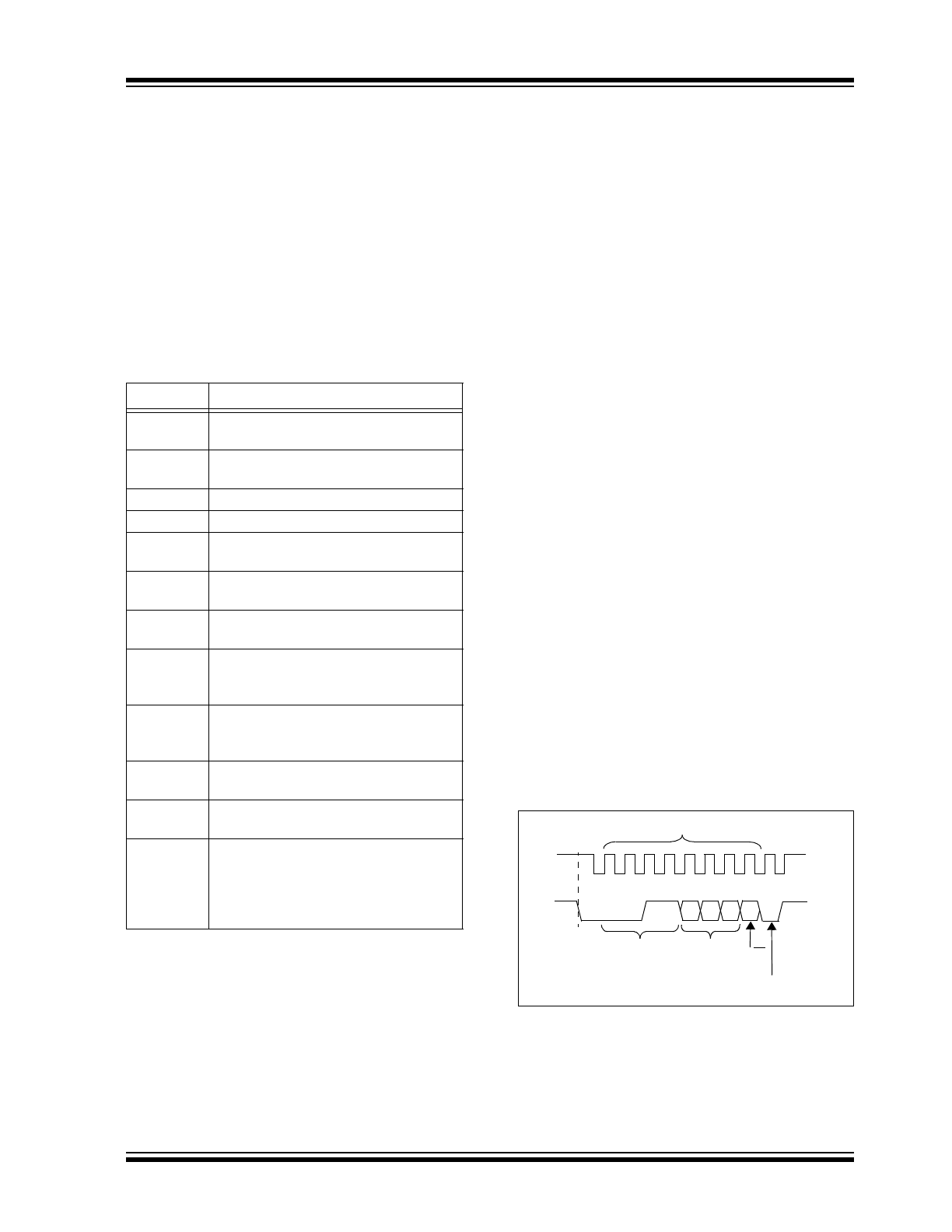
2012-2013 Microchip Technology Inc.
DS22327C-page 9
MCP98244
4.0
SERIAL COMMUNICATION
4.1
2-Wire Standard Mode I
2
C™
Protocol-Compatible Interface
The MCP98244 serial clock input (SCL) and the
bidirectional serial data line (SDA) form a 2-wire
bidirectional Standard mode I
2
C-compatible
communication port (refer to the
Input/Output Pin DC
Characteristics
Table and
Serial Interface Timing
Specifications
Table).
The following bus protocol has been defined:
TABLE 4-1:
MCP98244 SERIAL BUS
PROTOCOL DESCRIPTIONS
4.1.1
DATA TRANSFER
Data transfers are initiated by a Start condition
(START), followed by a 7-bit device address and a
read/write bit. An Acknowledge (ACK) from the slave
confirms the reception of each byte. Each access must
be terminated by a Stop condition (STOP).
Repeated communication is initiated after t
B-FREE
.
This device does not support sequential register read/
write. Each register needs to be addressed using the
Register Pointer.
This device supports the Receive Protocol. The
register can be specified using the pointer for the initial
read. Each repeated read or receive begins with a Start
condition and address byte. The MCP98244 retains the
previously selected register. Therefore, they output
data from the previously-specified register (repeated
pointer specification is not necessary).
4.1.2
MASTER/SLAVE
The bus is controlled by a master device (typically a
microcontroller) that controls the bus access and
generates the Start and Stop conditions. The
MCP98244 is a slave device and does not control other
devices in the bus. Both master and slave devices can
operate as either transmitter or receiver. However, the
master device determines which mode is activated.
4.1.3
START/STOP CONDITION
A high-to-low transition of the SDA line (while SCL is
high) is the Start condition. All data transfers must be
preceded by a Start condition from the master. A low-
to-high transition of the SDA line (while SCL is high)
signifies a Stop condition.
If a Start or Stop condition is introduced during data
transmission, the MCP98244 releases the bus. All data
transfers are ended by a Stop condition from the
master.
4.1.4
ADDRESS BYTE
Following the Start condition, the host must transmit an
8-bit address byte to the MCP98244. The address for
the MCP98244 Temperature Sensor is
‘0011,A2,A1,A0’ in binary, where the A2, A1 and A0
bits are set externally by connecting the corresponding
pins to V
DD
‘1’ or GND ‘0’. The 7-bit address
transmitted in the serial bit stream must match the
selected address for the MCP98244 to respond with an
ACK. Bit 8 in the address byte is a read/write bit.
Setting this bit to ‘1’ commands a read operation, while
‘0’ commands a write operation (see
Figure 4-1
).
FIGURE 4-1:
Device Addressing.
4.1.5
DATA VALID
After the Start condition, each bit of data in
transmission needs to be settled for a time specified by
t
SU-DATA
before SCL toggles from low-to-high (see
Serial Interface Timing Specifications
table).
Term
Description
Master
The device that controls the serial bus,
typically a microcontroller.
Slave
The device addressed by the master,
such as the MCP98244.
Transmitter Device sending data to the bus.
Receiver
Device receiving data from the bus.
START
A unique signal from master to initiate
serial interface with a slave.
STOP
A unique signal from the master to
terminate serial interface from a slave.
Read/Write A read or write to the MCP98244
registers.
ACK
A receiver Acknowledges (ACK) the
reception of each byte by polling the
bus.
NAK
A receiver Not-Acknowledges (NAK) or
releases the bus to show End-of-Data
(EOD).
Busy
Communication is not possible
because the bus is in use.
Not Busy
The bus is in the idle state, both SDA
and SCL remain high.
Data Valid
SDA must remain stable before SCL
becomes high in order for a data bit to
be considered valid. During normal
data transfers, SDA only changes state
while SCL is low.
1 2 3 4 5 6 7 8
9
SCL
SDA
0 0
1 1 A2 A1 A0
Start
Address Byte
Slave
Address
R/W
MCP98244
Response
Code
Address
A
C
K

MCP98244
DS22327C-page 10
2012-2013 Microchip Technology Inc.
4.1.6
ACKNOWLEDGE (ACK/NAK)
Each receiving device, when addressed, is obliged to
generate an ACK bit after the reception of each byte.
The master device must generate an extra clock pulse
for ACK to be recognized.
The acknowledging device pulls down the SDA line for
t
SU-DATA
before the low-to-high transition of SCL from
the master. SDA also needs to remain pulled down for
t
H-DATA
after a high-to-low transition of SCL.
During read, the master must signal an End-of-Data
(EOD) to the slave by not generating an ACK bit (NAK)
once the last bit has been clocked out of the slave. In
this case, the slave will leave the data line released to
enable the master to generate the Stop condition.
4.1.7
TIME OUT (T
OUT
)
If the SCL stays low or high for time specified by t
OUT
,
the MCP98244 resets the serial interface. This dictates
the minimum clock speed as indicated in the
specification.
